Whether one calls it “My-Moh” or “Me-Moh,” multiple input – multiple output (MIMO) technology is an integral part of today’s wireless communication standards. By deploying multiple antennas at the source and destination to transmit and receive data, MIMO manipulates multipath propagation to multiply a radio link’s capacity. Multiple data streams arrive at the destination receiver at different angles and slightly different times, facilitating efficient use of the radio frequency (RF) spectrum. Combining antennas optimizes data speed while diminishing errors; multiple antennas usually equate to higher speeds. While multipath propagation has historically been a source of signal interference, fading and phase shifting in conventional wireless communications, MIMO uses the phenomenon to “create a complex, 3-D frequency (see below) transmission.” Author and industry analyst Craig Mathias calls MIMO “the single most important technology in wireless today.”
Although the origins of MIMO spring from research dating back to the mid-1970s, the advent of the cellular phone networks demanded greater efficiencies in frequency use (and reuse). In 1996 Greg Raleigh, considered the inventor of MIMO, discovered that independent data streams utilizing co-located antennas and multi-variant signal processing could be efficiently transmitted by manipulating natural multipath propagation. With MIMO, multipath propagation is no longer an impediment; it’s necessary for the technology to work correctly.
Multiple input – multiple output (MIMO) technology
A “Spectrum” of Applications
MIMO has proven indispensable to the evolution of wireless communications (e.g., WLAN, Wi-Fi, cellular) and now extends to powerline communication (PLC) protocols. The technology has been standardized for IEEE 802.11n, IEEE 802.11ac, HSPA+ (3G) and WiMAX (4G) networks.
The three dimensional transmission mentioned above consists of frequency (the radio channel), time (bits per HZ) and space (multipath propagation). MIMO has been likened to 3-D computer graphics, which undoubtedly provides more input, communication and data content than 2-D. The flexibility of the technology allows for variants such as single-input, multiple-output (SIMO) and multiple-input, single-output (MISO) modes but the greatest efficiencies lie within the MIMO model. An aside: one may notice three numbers when dealing with MIMO networks, say 3x3x2. The first number is the number of transmit antennas, the second the number of receive antennas and the third the number of data streams.
Researchers drool over MIMO because it’s the most efficacious means of maximizing wireless performance. Rather than use techniques like channel bonding to add more bandwidth, MIMO receives and processes three (for example) separate signals “up the stack,” i.e., the top layers of network communication. This technique greatly improves the receiver’s ability to process data found in the RF. See the diagram below. Note that the “MIMO Processed Signal” is an amalgam of the three antenna signals.

Mix and Match: The 3 Elements of MIMO
MIMO transmits data by using one or a combination of the following processing techniques:
Precoding takes advantage of channel-side information at the transmitter (CSIT). Precoding essentially is beamforming for multiple layer radio transmissions. Beamforming aka spatial filtering, per Wikipedia, “is a signal processing technique used in sensor arrays for directional signal transmission or reception.”
Spatial Multiplexing (SM or SMX) utilizes multiple source antennas to send individual separately encoded data transmissions, hence repeatedly multiplexing or reusing the multipath propagation dimension.
Diversity Coding System a fault-tolerant method of transmitting data when channel knowledge is unavailable at the transmission source. Unlike precoding or SMX, a single data stream is transmitted using space-time coding. This method takes advantage of fading typically found in antenna array links to intensify signal variance and can be used in conjunction with SMX if the source transmitter provides some channel knowledge.
This brief Spirent Communications video explains how MIMO works:
MIMO Applications and Options
SmartPhones, as one might expect, are an obvious application of MIMO technology. Since Precoding, SMX and Diversity Coding are complex transmission techniques, SmartPhones (and other portable wireless destination devices such as tablets) utilize the 4G LTE and HSPA+ standards to efficiently receive and process data streams. On the other hand, WiFi (e.g., IEEE 802.x) uses Orthogonal frequency division multiplexing (OFDM) or Orthogonal frequency multiple access (OFDMA) modulation for data transmission and processing. The IEEE 802.16e (Broadband Wireless) standard integrates MIMO-OFDMA; IEEE 802.11n (Wireless LAN) integrates MIMO-OFDM.
Mobile radio telephone standards like the 3rd Generation Partnership Project (3GPP) and 3rd Generation Partnership Project 2 (3GPP2) also incorporate MIMO. Again, showing its native forward- and backward-looking flexibility, MIMO standards can be applied to both these competing technologies which significantly differ from each other, e.g. Global System for Mobile Communications (GSM) versus Code Division Multiple Access (CDMA).
Another example of MIMO’s flexibility and utility of application is found in the the home networking standard ITU-T G.9963, which designates a communications systems over powerlines using AC phase, neutral and ground wires to transmit multiple data streams.
Besides WLANs, mobile and cellular communication applications, MIMO is poised for deployment in metropolitan area networks (MANs) and digital television. It is truly a versatile technology and one that lives up to its hype.
Coda
To explain “MIMO in plain terms,” consider the following from Samsung lead technical researcher Rushabh Vakharia:
If you have 2 pipes connected to water supply, you’ll get more water. Add more pipes and get even more water. Same with MIMO; add more antennas and get (higher) data speeds. But every antenna and pipe comes at a cost and makes the arrangement more complex, so it’s an (accommodation) between cost and need. That’s MIMO in plain terms.